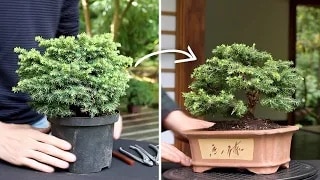When should I apply wire?
Most tree species can be wired at any time of the year. Deciduous trees however are much easier to wire in late winter due to the absence of leaves. Be attentive when applying wire during the growing season as branches grow thick quite fast, which can result in ugly scars from the wire cutting into the bark. Check on your tree regularly and make sure to remove the wire on time.
Types of wire
There are two kinds of wire that can be used for Bonsai: Anodized aluminum and annealed copper. Aluminum wire is better when used for deciduous species, while the harder copper wire is best for conifers and pines. However, If you're a beginner we advise you to use the anodized aluminum wire. It is easier to work with and sold in most online Bonsai stores.
Wire is available in sizes from 1-8mm thick (gauges 20 to 2). There is no need to purchase every available wire gauge. We suggest starting with; 1mm, 1.5mm, 2.5mm, and 4mm thick wires. When wiring thick branches we recommended wrapping them with raffia soaked in water first, to protect the branches from being damaged by the wire when shaping. Raffia is a palm fiber that's available in most garden supply centers.


How to wire a Bonsai tree
Wiring can be a tricky technique to master. Whenever possible, wire two branches of similar thickness near each other using a single piece of wire. This technique is known as 'double-wiring' and it provides more support for both branches. The remaining branches should be wired separately using single-wiring. Make sure to wire all the branches you intend on shaping before actually bending them. When wiring an entire Bonsai tree, work from the trunk to the primary branches, and then start wiring the secondary branches. As a rule of thumb, use wires that are 1/3 of the thickness of the branch you are wiring. The wire should be thick enough to hold the branch in its new position.
We will discuss both double and single wiring techniques in more detail now, and we'll cover how to safely bend the wired branches at the end of this section. Follow this step-by-step guide, and be sure to use the right wire and Bonsai tools.

Bending the wired branches
Once the entire tree is wired, you can begin bending and repositioning the branches. Hold the outside of the branch you want to bend with your fingers and bend the branch from the inside of the curve with your thumbs. it's important to apply force on the inside of the branch to reduce the risk of splitting. When the branch is positioned where you want it, refrain from moving it. Repeated bending will likely damage the branch. Try to bend straight sections of branches slightly to make them look more natural.
Guy-wires
Guy-wiring is a method of bending branches downwards when they are too thick, old, or brittle to be bent with coiled wire. Be sure to anchor your guy-wires on sturdy points such as a strong surface root, a strong branch, or even the pot. The guy wire is usually a thin (1mm) wire. Make sure to protect the branch with a small piece of rubber or plastic as the wire will put a considerable amount of force on it, also see the step-by-step guide below for more detail.
Aftercare
It's important to keep a watchful eye on the tree during the growing season so the wires don't damage your tree. Branches will grow around the wires in 1-4 months, depending on how fast the tree grows, damaging the bark and leaving permanent scars. Make sure you remove the wires before they start digging into the bark. When removing wiring, it's best to cut the wire at every turn. Do not try to recycle wire by unwinding it off of the branches. Unwinding will most likely damage the tree.














